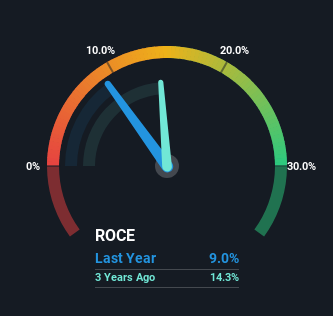Slowing Rates Of Return At UPL (NSE:UPL) Leave Little Room For Excitement
Finding a business that has the potential to grow substantially is not easy, but it is possible if we look at a few key financial metrics. Firstly, we'll want to see a proven return on capital employed (ROCE) that is increasing, and secondly, an expanding base of capital employed. This shows us that it's a compounding machine, able to continually reinvest its earnings back into the business and generate higher returns. Although, when we looked at UPL (NSE:UPL), it didn't seem to tick all of these boxes.
Our free stock report includes 2 warning signs investors should be aware of before investing in UPL. Read for free now.Return On Capital Employed (ROCE): What Is It?
If you haven't worked with ROCE before, it measures the 'return' (pre-tax profit) a company generates from capital employed in its business. The formula for this calculation on UPL is:
Return on Capital Employed = Earnings Before Interest and Tax (EBIT) ÷ (Total Assets - Current Liabilities)
0.09 = ₹54b ÷ (₹880b - ₹286b) (Based on the trailing twelve months to March 2025).
Therefore, UPL has an ROCE of 9.0%. Ultimately, that's a low return and it under-performs the Chemicals industry average of 13%.
View our latest analysis for UPL

In the above chart we have measured UPL's prior ROCE against its prior performance, but the future is arguably more important. If you're interested, you can view the analysts predictions in our free analyst report for UPL .
What Can We Tell From UPL's ROCE Trend?
Things have been pretty stable at UPL, with its capital employed and returns on that capital staying somewhat the same for the last five years. Businesses with these traits tend to be mature and steady operations because they're past the growth phase. So unless we see a substantial change at UPL in terms of ROCE and additional investments being made, we wouldn't hold our breath on it being a multi-bagger.
In Conclusion...
In summary, UPL isn't compounding its earnings but is generating stable returns on the same amount of capital employed. Yet to long term shareholders the stock has gifted them an incredible 109% return in the last five years, so the market appears to be rosy about its future. But if the trajectory of these underlying trends continue, we think the likelihood of it being a multi-bagger from here isn't high.
On a final note, we've found 2 warning signs for UPL that we think you should be aware of.
While UPL isn't earning the highest return, check out this free list of companies that are earning high returns on equity with solid balance sheets.
New: AI Stock Screener & Alerts
Our new AI Stock Screener scans the market every day to uncover opportunities.
• Dividend Powerhouses (3%+ Yield)
• Undervalued Small Caps with Insider Buying
• High growth Tech and AI Companies
Or build your own from over 50 metrics.
Have feedback on this article? Concerned about the content? Get in touch with us directly. Alternatively, email editorial-team (at) simplywallst.com.
This article by Simply Wall St is general in nature. We provide commentary based on historical data and analyst forecasts only using an unbiased methodology and our articles are not intended to be financial advice. It does not constitute a recommendation to buy or sell any stock, and does not take account of your objectives, or your financial situation. We aim to bring you long-term focused analysis driven by fundamental data. Note that our analysis may not factor in the latest price-sensitive company announcements or qualitative material. Simply Wall St has no position in any stocks mentioned.
About NSEI:UPL
UPL
Manufactures and sells pesticides, insecticides, and micronutrients in India, Brazil, the United States, the United Kingdom, and internationally.
Adequate balance sheet average dividend payer.
Similar Companies
Market Insights
Community Narratives




